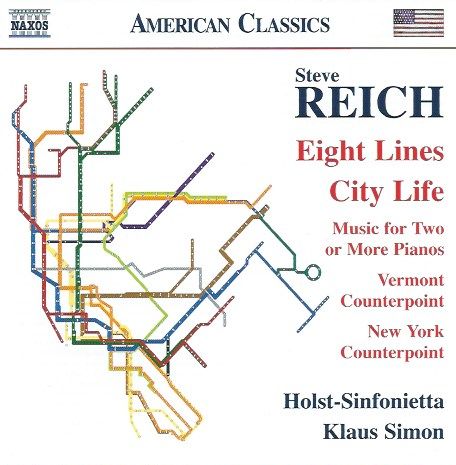City Life: The music of Steve Reich

This is a terrific introduction to the music of the minimalist composer Steve Reich. Previously on Classical Explorer, we encountered the Labèque sisters in the music of fellow minimalist Philip Glass; with this release, we expand the remit to Reich, anothe rof the most significant voices in this area.
This is a chronoloogical survey and so the first piece we hear, Music for Two or More Pianos (1964), in a World Premiere recording. The sense of space might be seen to invite in the etrnals of the music of Mortan Feldman; but some have seen influences of the jazz pianist Bill Evans later on:
It is a more modernist piece than one might associate with Reich, with little of the sense of regular pulse that is so integral to modernism. As a piece in its own right, it is a fascinating jewel, a celebration of the quiet, with perhaps some hints of John Cage in the prepared elements to the pianos.. It is performed here by Klaus Simon (who eslewhere conducts the Holst-Sinfonietta) and Jòrg Schweinbenz.
The more familiar sound signatiure of Steve Reich comes forth in Eight Lines (1979/83), where locomotive, chugging rhythms power the piece forward. 17 minutes of disciiplined minimalism contain eight lines each of which ahs a distinct role, from the two pianos' patterns,f rom which the clarinets and flutes derive the second 'line,' and so on. It is a masterpiece of the art of minimalism, and required playing of equal discipine. Step forwards the Holst-Sinfonietta:
It is a completely different world: active yet static at the same time (there's lots happening on teh surface, but the harmonic rate of chamge is slow; and the rate of change of melodic shapes is similarly glacial).
Both Vermont Counterpoint (1982) and New York Counetrpoimt (1985) are more famous. For flute and tape, Vermont Counterpoint has a sort of avian freshness
New York Counterpoint is the most sophisticated piece on the disc in its use of layering different strata ecah of which seems to arrive with utter naturalness. It is heard here in its version for clarinet and tape: here's the first movement (note YouTube claims crotechet equals 18 but it actually equals 184):
The characteristic Reich pulsings are beautifully done here (another aspect of that discipline we discussed earlier); plus, there's real humour in the finale.
Finally, City Life (1995), for ensemble, a sound painting in five movements of New York. One hears the hustle and bustle and the honking of car horns; it also poignantly includes speech samples in the finale from the first bomb attack on the World Trade Center in 1993.
As an introduction to the music of Steve Reich, this is a great disc. Thoroughly enjoyable throughout, and presented in bright, clear sound, it is a real bargain.
